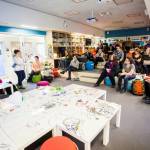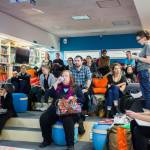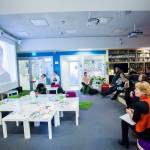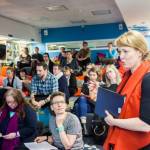The research project “Making Spaces for Social Justice and Equality” organized a discussion event on the intersections of art and research at on 25 February 2016.
The capacity of art to generate a variety of interpretations and cast the familiar into a new light has interested researchers for a very long time. Academic researchers and artists often explore similar societal and political questions. Yet, practices of knowledge production in research and arts have remained disconnected.
The discussion event sought to unravel why this is the case as well as to generate reflection on the possibilities of collaboration between research and arts practice. Eeva Puumala from the University of Tampere presented about her experiences working in the art/research interface.
She focused in particular on her participation in the “Floating Platforms project” which is a platform for new kinds of encounters between performance art and research. Puumala suggested that research can learn from art a degree of playfulness characteristic of experimental methods. Working in this way, she argued, may leave more room for the unexpected to happen than conventional social scientific research.
Masha Godovannaya is a St. Petersburg-based visual artist, curator and social scientist who told the audience about her project “She. The title of the artist“. This is a feminist art-research project bringing together areas such as artistic research, sociology of art, visual sociology, art-history and curatorial research. The project explores the role and the status of women in two institutions which form the Russian Academy of Fine Arts.
Godovannaya also posed a set of questions that have to do with practices through which stuff is produced collectively, also a set ethical issues involved in these sorts of projects.
Saara Särmä, a feminist, scholar and artist from Tampere, presented her experiences of mixing methods from social scientific research and artistic practice. Särmä also problematized identities of an artist or a researcher showing that to call oneself an artist or a researcher is very much a political issue.
Comments were provided by Tere Vadén. He suggested that there are possibilities as well as problems involved in the fact that both research and art are institutions with impose subjects with rather strict identities. While crossing over and shifting one’s identity is possible, it is not always uncomplicated.
At the discussion participants elaborated on various kinds of interventions through which it is possible to encourage intersectoral knowledge production.
Photos: Jonne Renvall / University of Tampere





Comments